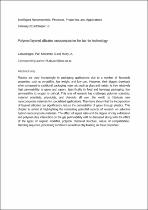JavaScript is disabled for your browser. Some features of this site may not work without it.
- ResearchSpace
- →
- Research Publications/Outputs
- →
- Book Chapters
- →
- View Item
| dc.contributor.author |
Labuschagne, Philip W

|
|
| dc.contributor.author |
Moolman, S

|
|
| dc.contributor.author |
Maity, Arjun

|
|
| dc.date.accessioned | 2013-03-25T07:08:26Z | |
| dc.date.available | 2013-03-25T07:08:26Z | |
| dc.date.issued | 2012-02 | |
| dc.identifier.citation | Labuschagne, PW, Moolman, S and Maity, A. 2012. Polymer/layered silicates nanocomposites for barrier technology. In: Intelligent Nanomaterials: Processes, Properties, and Applications. John Wiley & Sons Publishing: Hoboken, NJ, USA. | en_US |
| dc.identifier.isbn | 0-470-93879-X | |
| dc.identifier.isbn | 978-0-470-93879-9 | |
| dc.identifier.uri | http://onlinelibrary.wiley.com/doi/10.1002/9781118311974.ch13/summary | |
| dc.identifier.uri | http://hdl.handle.net/10204/6618 | |
| dc.description | Copyright: 2012 Wiley-Scrivener Publishing,Hoboken, NJ, USA | en_US |
| dc.description.abstract | Plastics are used increasingly in packaging applications due to a number of favorable properties, such as versatility, low weight, and low cost. However, their biggest drawback when compared to traditional packaging materials, such as glass and metals, is their relatively high permeability to gases and vapors. Specifically in food and beverage packaging, low permeability to oxygen is critical. This area of research has challenged polymer scientists, material scientists, physicists, and chemists all over the world to fabricate new nanocomposite materials for specialized applications. They have shown that the incorporation of layered silicates can significantly reduce the permeability of gases through plastics. This chapter is aimed at highlighting the interesting potential aspects of research on selective hybrid nanocomposite materials. The effect of aspect ratio and the degree of clay exfoliation and polymer-clay interaction on the gas permeability will be discussed along with the effect of the types of organic modifier, polymer chemical structure, nature of compatibilizer, blending sequence, processing conditions as well as clay loading on these properties. | en_US |
| dc.language.iso | en | en_US |
| dc.publisher | Wiley-Scrivener | en_US |
| dc.relation.ispartofseries | Workflow;8191 | |
| dc.subject | Nanocomposites | en_US |
| dc.subject | Nanomaterials | en_US |
| dc.subject | Plastics | en_US |
| dc.subject | Polymers | en_US |
| dc.subject | Food packaging | en_US |
| dc.subject | Bevarage packaging | en_US |
| dc.title | Polymer/layered silicates nanocomposites for barrier technology | en_US |
| dc.type | Book Chapter | en_US |
| dc.identifier.apacitation | Labuschagne, P. W., Moolman, S., & Maity, A. (2012). Polymer/layered silicates nanocomposites for barrier technology., <i>Workflow;8191</i> Wiley-Scrivener. http://hdl.handle.net/10204/6618 | en_ZA |
| dc.identifier.chicagocitation | Labuschagne, Philip W, S Moolman, and Arjun Maity. "Polymer/layered silicates nanocomposites for barrier technology" In <i>WORKFLOW;8191</i>, n.p.: Wiley-Scrivener. 2012. http://hdl.handle.net/10204/6618. | en_ZA |
| dc.identifier.vancouvercitation | Labuschagne PW, Moolman S, Maity A. Polymer/layered silicates nanocomposites for barrier technology.. Workflow;8191. [place unknown]: Wiley-Scrivener; 2012. [cited yyyy month dd]. http://hdl.handle.net/10204/6618. | en_ZA |
| dc.identifier.ris | TY - Book Chapter AU - Labuschagne, Philip W AU - Moolman, S AU - Maity, Arjun AB - Plastics are used increasingly in packaging applications due to a number of favorable properties, such as versatility, low weight, and low cost. However, their biggest drawback when compared to traditional packaging materials, such as glass and metals, is their relatively high permeability to gases and vapors. Specifically in food and beverage packaging, low permeability to oxygen is critical. This area of research has challenged polymer scientists, material scientists, physicists, and chemists all over the world to fabricate new nanocomposite materials for specialized applications. They have shown that the incorporation of layered silicates can significantly reduce the permeability of gases through plastics. This chapter is aimed at highlighting the interesting potential aspects of research on selective hybrid nanocomposite materials. The effect of aspect ratio and the degree of clay exfoliation and polymer-clay interaction on the gas permeability will be discussed along with the effect of the types of organic modifier, polymer chemical structure, nature of compatibilizer, blending sequence, processing conditions as well as clay loading on these properties. DA - 2012-02 DB - ResearchSpace DP - CSIR KW - Nanocomposites KW - Nanomaterials KW - Plastics KW - Polymers KW - Food packaging KW - Bevarage packaging LK - https://researchspace.csir.co.za PY - 2012 SM - 0-470-93879-X SM - 978-0-470-93879-9 T1 - Polymer/layered silicates nanocomposites for barrier technology TI - Polymer/layered silicates nanocomposites for barrier technology UR - http://hdl.handle.net/10204/6618 ER - | en_ZA |






